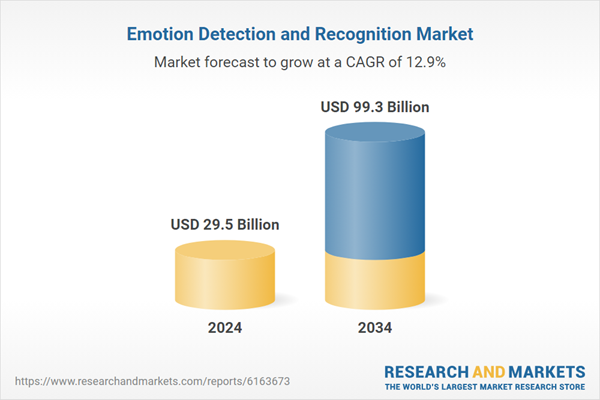Public opinion remains divided over some key technologies, such as facial recognition, with ongoing conversations centered around privacy and ethical deployment. Educational and certification programs for EDR professionals are emerging in response, incorporating ethical AI training and social accountability. North America is leading the market due to robust investments in healthcare AI, vehicle safety applications, and strong research institutions, while the Asia-Pacific region is rapidly catching up, backed by aggressive digital transformation policies and AI investments across countries like India, China, and South Korea. The market’s growth is further strengthened by evolving regulatory frameworks and expanding industrial AI integrations across global regions.
The software segment held a 46% share in 2024 and is expected to grow at a CAGR of 3.8% through 2034. This segment encompasses emotion AI platforms capable of facial analysis, voice recognition, and multimodal data processing. Continuous improvements in natural language processing and neural network architectures are driving innovation across this segment. These software tools are widely implemented in use cases such as emotion-based customer analytics, mental health diagnostics, and employee screening. AI-led solutions in this space are gaining traction as businesses increasingly invest in platforms that offer real-time emotional intelligence to enhance service personalization and operational insights.
The facial recognition systems segment held a 27% share in 2024 and is anticipated to grow at a CAGR of 10.7% through 2034. This segment leads due to its high adoption across automotive safety technologies, retail analytics, and monitoring tools. Facial analysis systems enable accurate assessment of user emotions, driver alertness, and consumer reactions in various environments. With hardware performance improving and facial analysis becoming more refined, its integration in smart surveillance and behavioral evaluation platforms continues to expand.
United States Emotion Detection and Recognition Market held an 85% share and generated USD 9.8 billion in 2024. The country's leadership stems from a mature healthcare infrastructure, broad implementation of AI in digital services, and ongoing innovation in connected vehicles and educational platforms. Emotion AI is increasingly used to personalize patient care, analyze classroom engagement, monitor road safety, and improve user experience across industries. Strong investments in intelligent systems and AI integration have made the US a central hub for emotion analytics development.
Key industry players shaping the Global Emotion Detection and Recognition Market include Kairos AR, Apple, Realeyes, Amazon Web Services (AWS), Entropik, IBM, Google (Alphabet), Microsoft, Uniphore, Smart Eye (Affectiva), and Verint. These companies are actively innovating in AI-driven emotional intelligence and multimodal analytics to gain a competitive advantage. Industry leaders are focusing on advanced analytics platforms, scalable APIs, and emotion datasets to improve model accuracy across multiple languages and cultures. Strategic collaborations with automotive, healthcare, and retail sectors enable these companies to embed EDR technologies into real-world environments. Several firms are enhancing their offerings through acquisitions and by aligning with ethical AI guidelines to meet regulatory requirements and user trust standards.
This product will be delivered within 2-4 business days.
Table of Contents
Companies Mentioned
The companies profiled in this Emotion Detection and Recognition market report include:- Amazon Web Services
- Apple (Emotient)
- Facebook (Meta Platforms)
- IBM
- Intel
- Microsoft
- NVIDIA
- Affectiva (Smart Eye)
- Beyond Verbal Communications
- Cogito
- Elliptic Labs
- Eyeris Technologies
- Kairos AR
- Noldus Information Technology
- Realeyes (Attention Insight)
- Sightcorp
- AnyVision
- Avanade
- Cognitec Systems
- Facefirst
- Hume AI
- Paravision
- Trueface
- Uniphore
- VoiceSense
Table Information
| Report Attribute | Details |
|---|---|
| No. of Pages | 210 |
| Published | July 2025 |
| Forecast Period | 2024 - 2034 |
| Estimated Market Value ( USD | $ 29.5 Billion |
| Forecasted Market Value ( USD | $ 99.3 Billion |
| Compound Annual Growth Rate | 12.9% |
| Regions Covered | Global |
| No. of Companies Mentioned | 27 |









